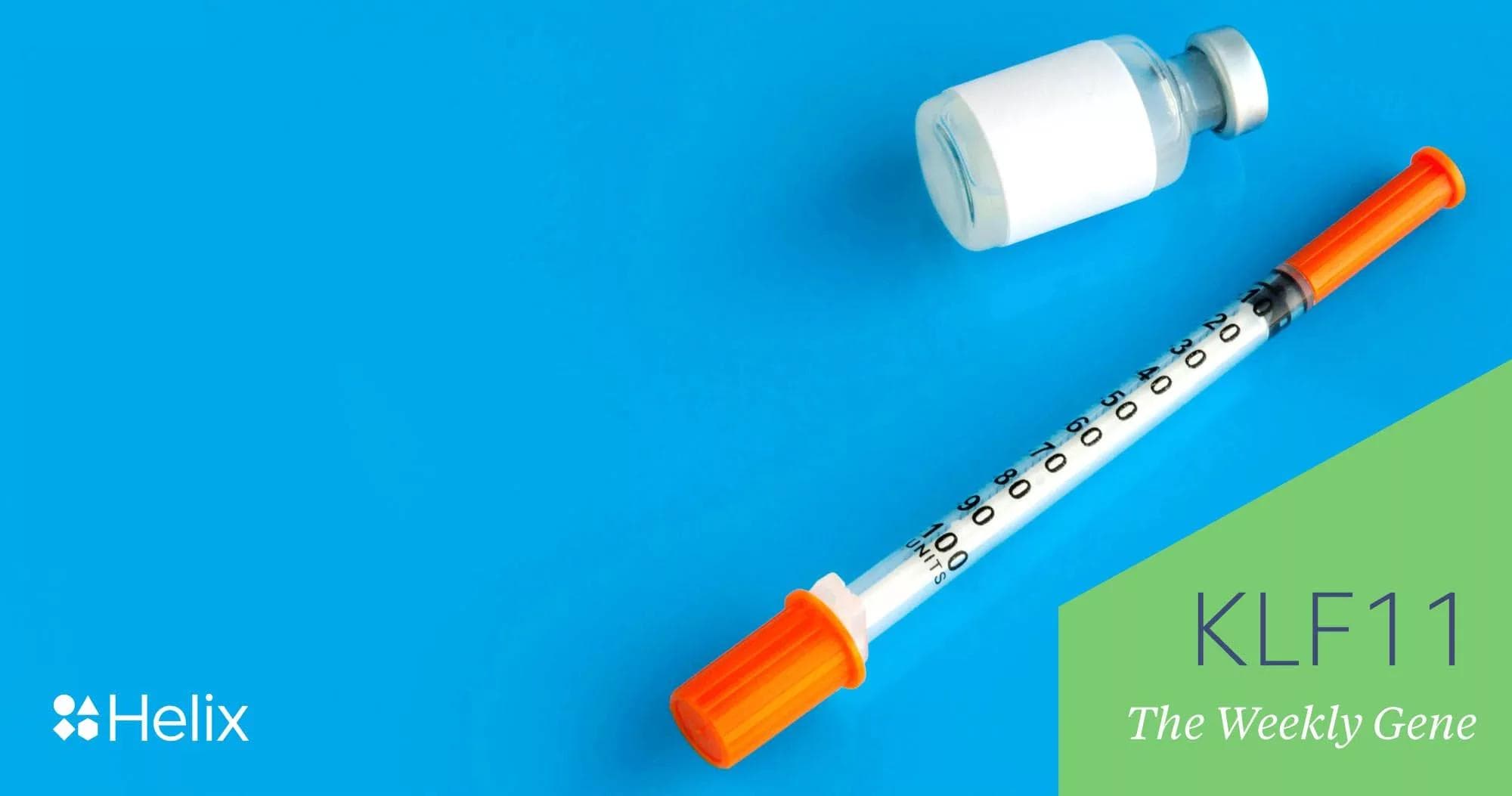Diabetes, space-saving DNA, and a very important gene

Last week, you might recall that we looked at a gene called PDX1, a critical DNA sequence that plays a role in the development of a certain type of diabetes—and the actual development of the pancreas in human embryos. Now, as Diabetes Awareness Month continues, let’s take a look at another gene with major implications for sugar regulation. This week we’re focusing on KLF11, an important player in histone modifications (more on that shortly) that can play a role in a rare form of diabetes known as Maturity Onset Diabetes of the Young (MODY).
Every cell in the body has a nearly identical set of genes, but when and where these genes are read helps determine the identity and function of any given cell. For example, a neuron in the brain uses genes that instruct it on how to be a neuron. It is equally important that this neuron ignore other genes that carry instructions that are unrelated to neuron function. To do this, our body has developed ways of controlling when a gene is read.
Histone modifications relate to one method of controlling access to genes. DNA is stored within our cells as a combination of both DNA and a class of proteins known as histones. Histones are like genetic “hair curlers,” in that DNA can be wound tightly around them. This allows large amounts of DNA (around 6 feet of DNA in a single cell!) to be stored in microscopic structures known as chromatin. This can be problematic, though, because tight winding of the DNA can leave genes inaccessible—they can’t be used if they’re too tightly wound up.
This is where histone modification comes into play. Specialized proteins can be recruited to chromatin where they attach molecular flags to the histones that border specific DNA locations, making the DNA more (or less) accessible. This is one of the ways a cell can regulate when a gene is used.
Diabetes can be a complex disease
During development of the pancreas, KLF11 helps regulate histone modifications around important genes such as PDX1, a critical regulator of pancreatic function1. To regulate histone modifications, it’s important that KLF11 be able to interact with both the DNA and with specialized signaling proteins. These specialized proteins bind to KLF11, which temporarily anchors them to that genomic location. Once there, these proteins are able to attach molecular marks to the histones. In the case of PDX1, KLF11 attaches to the gene and activates it1. However, variations in KLF11 can decrease the amount of PDX1 protein, leading to a rare form of diabetes known as Maturity Onset Diabetes in the Young (MODY)2.
Aside from its effects on PDX1, KLF11 helps to control some genes involved in the regulation of blood sugar, including the production of insulin3. Variations in the DNA sequence coding for KLF11 may disrupt its ability to interact with activating proteins involved in the regulation of insulin. As a result, KLF11 variants may instead interact with repressive proteins which make the insulin gene less accessible. Individuals who inherit these variations have trouble producing insulin and maintaining healthy blood sugar levels, which results in MODY1-3.
There are multiple forms of MODY, each one resulting from a different genetic variant in one of 13 different genes (including KLF11)4. It has been suggested that 1-5% of diabetics currently have some form of MODY, but most are unaware because symptoms of MODY can resemble features of both Type 1 and Type 2 diabetes5. Those with MODY may be able to start treatment regimens that manage their symptoms more effectively and have minimal impact on their quality of life. In some instances, treatment of MODY may not require daily injections of insulin, which can be burdensome. Instead, these cases may be treatable with physical exercise and diet intervention, or with therapeutics that can be taken as a pill4-5.
Diabetes can be a complex disease, but it’s manageable, especially with modern understanding of how genes like KLF11 work.
1Fernandez-Zapico, Martin E. et al. “MODY7 Gene, KLF11, Is a Novel p300-Dependent Regulator of Pdx-1 (MODY4) Transcription in Pancreatic Islet Β Cells.” The Journal of Biological Chemistry 284.52 (2009): 36482–36490. PMC. Web. 8 Nov. 2017.
2Neve, Bernadette et al. “Role of Transcription Factor KLF11 and Its Diabetes-Associated Gene Variants in Pancreatic Beta Cell Function.” Proceedings of the National Academy of Sciences of the United States of America 102.13 (2005): 4807–4812. PMC. Web. 8 Nov. 2017.
3Lomberk, Gwen et al. “Krüppel-like Factor 11 Regulates the Expression of Metabolic Genes via an Evolutionarily Conserved Protein Interaction Domain Functionally Disrupted in Maturity Onset Diabetes of the Young.” The Journal of Biological Chemistry 288.24 (2013): 17745–17758. PMC. Web. 8 Nov. 2017.
4Gardner, Daphne SL, and E Shyong Tai. “Clinical Features and Treatment of Maturity Onset Diabetes of the Young (MODY).” Diabetes, Metabolic Syndrome and Obesity: Targets and Therapy 5 (2012): 101–108. PMC. Web. 2 Nov. 2017
5Kleinberger, Jeffrey W., and Toni I. Pollin. “Undiagnosed MODY: Time for Action.” Current diabetes reports 15.12 (2015): 110. PMC. Web. 8 Nov. 2017.